Why are we attracted to and mesmerized by evil people in horror cinema and novels? Gloomy Sunday's Gothic-romantic, Absinthe, kicks off this round of commentary from the League of Tana Tea Drinkers to explore this question. From Bela Lugosi to Freddy Kruger, the league pokes and prods as only it can do, to unearth the answers, the assumptions, and the contradictions.
Gloomy Sunday explores the bad boys of screen and novel...
Why are we attracted to villains? Why are we drawn towards characters we really should hate? Why do we sometimes find sex appeal in characters who are hideous or deformed? Is it we can relate better to people who have flaws, people who are more realistically human with their dark sides instead of the cookie cutter heroes and heroines we usually see in movies? Or does it go deeper, to an instinctual level, left over from a more primitive time, when only the strong thrived and reproduced, drawing us to the powerfully wicked onscreen?
Pinhead from Clive Barker's The Hellbound Heart and the later Hellraiser movies--although I only speak for the first two because after that they suck--is one of my favorite villains and one I think has strong sexual appeal despite his skin being the color of a dead fish, with nails protruding from his head, and a strange, but kinky, sadomasochistic leather outfit hinting at damnation. If you wanted to, you could compare the premise Hellraiser is based on to a metaphor for sexual freedom by looking at the puzzle box, which involves a quest for something much desired, yet secret, dark, and forbidden to have. If Pinhead quickly came into scene and dispatched his victims, we would not be so drawn to him. Instead, he shows human characteristics we can relate to. In Hellbound, Hellraiser II he does not kill Tiffany when she opens the box because he knows that "hands did not call us, desire did." He seems fair even though he is a killer, and he continually lets Kirsty slip through the damning cracks by allowing deals and bargains. Is it his power we are drawn to, the relief provided by his human flaws that we can relate to, or the subtext of sublime sexual naughtiness he is the front man for?
Hannibal Lecter, from Thomas Harris' series of novels and the movies, is a cold blooded killer that eats his victims. Yet, he is the star in everything he appears in--even stealing some of the show in Red Dragon where he only has a bit part. Silence of the Lambs is basically a sick and twisted love story between Hannibal and Clarice. Hannibal is such a successful character, Harris pretty much wrote the last book of the series for his fans who couldn't get enough of the sophisticated predator with a penchant for fine wine and human sweetmeats. Why are we drawn to a cannibal doctor? I think this one is almost the same as Pinhead - he is fair, he has his flaws, but he still has a good side. He prefers to only eat "the rude" and we practically cheer when he does away with some of his victims. So what does that say about us? Deep down, do we want to "devour" our enemies to?
What about Freddy Krueger, from Wes Craven's long-running series of movies; though try to think of the first few movies where Freddy is dark and menacing and not prone to stand up comedy. This one is a little harder to defend because he really doesn't have a "good" side. He is more an out and out killer, and even worse, a pedophilic murderer (remember Matchbox's ill-conceived Freddy Kruger talking doll for kids?). His hideously burned body and razor-glove belies the corruption buried deep within him. So for all these points against him, why do we still like him? Why do we have this "love to hate" attitude about Freddy?
Perhaps it is the same reason the girls are often drawn to "bad boys;" they are darkly dangerous, powerful in their recklessness, and yet we want to possess them, somehow tame them under our control. Just think of all the Byronic heroes from your romance fiction (from Gothic to regency to contemporary they abound). With all their dangerous power, they are flawed and have secrets, yet we are still drawn to them. Perhaps the danger part is appealing. Maybe it even goes back to the basics of survival: the strong survive so we are drawn to the powerful figures that would most likely survive in a hostile world. Maybe we even see something mirrored in them that we would like to reflect in ourselves, making us as free as they are, letting our darker sides and instincts all hang out without a care or worry.
From the world of the pulp novel our heroines more often than not are attracted to the dark, foreboding males. These characters are usually temperamental, anti-social, have a lack of morals, prone to fits of rage, jealousy, and are often sarcastic and gruff. They will often annoy the heroine, lie to her, make fun of her, physically hurt her or even force themselves on her. Yet she is still drawn to them when all logic says she should be repelled. What is it that makes us go weak in our knees over the bad boys?
In my humble opinion, which will no doubt set the feminist's teeth on edge, it's all about the power, baby. If you put a typical Byronic hero or anti-hero with one of those good guys, the good guy is going to lose. He's going to get his ass kicked. Sometimes in this world to survive you have to lie, cheat, steal, and the anti-hero will have no problem doing that. The good guy will assess the morality and weigh the pros and cons while our dark hero is already through the door.
I'd also like to mention at this point the Stockholm Syndrome, in which a kidnap victim falls in love with her captor. That is an extreme example but it has been documented in many cases, even when the victim was almost murdered by her captor. When we look at most of these novels, our heroine is put into some extraordinary situation where her life is usually threatened and she is driven to the very brink of her being. So when the anti-hero throws her a little bone, no matter how small - she is grateful and starts to fall in love with him, never mind that most people think he killed his first wife.
So does this mean that we are all going to run out and marry assholes? Not quite. Even though our base instincts may seek out the anti-heroes, we are still going to weigh other important characteristics; does he have a job, does he have the same morals, likes and dislikes. You will notice that at the end of these novels, the characters usually marry. They are happy, they are blissful and that's it--The End. We don't get to see what their lives are like after the fact. I think most of these marriages will eventually break up, because when you are dealing with typical Byronic traits, it would make a person a little hard to live with. And in the end these are just novels and movies, a way for us to escape ourselves and enjoy a fantasy, a flirtation with the darker side of alluring evil.
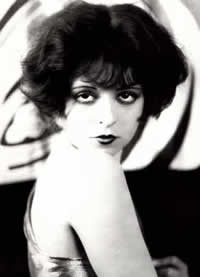 And Now the Screaming Starts blog looks at Dracula, the It Girl, and how another's corruption can make us pure...
And Now the Screaming Starts blog looks at Dracula, the It Girl, and how another's corruption can make us pure...
There is this old show biz story about Bela Lugosi. In 1927, the stage play of Dracula made the leap over the pond and was making waves on Broadway. In the role of the titular bloodsucker was Lugosi, then a former fixture on the NYC ethnic theater circuit who'd had his "big break" playing a terrorist bent on destroying the Panama Canal in 1923's The Silent Command. During the play's long and successful run, Lugosi was backstage putting on the dapper costume of the count. Some of the other actors noticed a latticework of red claw marks criss-crossing his back. Still struggling with English (for the play, Lugosi memorized many of his lines without fully understanding their meaning) Lugosi sheepishly gave his curious fellow thespians a simple and precise explanation of the damage: "Clara."
Lugosi was referring to Clara Bow, the ultra-flapper and famed "It Girl."
Is the story true? There's reason to believe it is. In 1929, Lugosi married a wealthy San Francisco widow named Beatrice Weeks. Just three days after Lugosi and Weeks tied the knot, they were divorced. Weeks claimed that Bow was the reason. But it's fair to be skeptical about the details: the implied violence of Bow's lovemaking, the comedic casting of the vampire as the victim of the girl. Bow's appetites were the subject of many a salacious rumor. Ken Anger's Hollywood Babylon, for example, famously proposed that Bow banged the entire USC football team, including a young player who would go on to become John Wayne.
However, these rumors remain, even today, nothing more than rumors. The claw marks could be, like so many torrid Tinseltown tall tales, an example of that curious sub-genre of urban myth: the "Hollywood as she really is" story. Part shameless display of fascinated prurience, part exercise in puritanical moral superiority, these stories are told to get a grasp on the weirdness that is popular culture industry: a beast that is at once the fascinating puppet master and pathetic parasite of our imagination. Which leads us back to the figure of the vampire . . .
Let's not sweat whether the story is factually true. That the story survives (you can find a version of it the Universal Anniversary Edition Dracula DVD extras) means it is real in that it says something real about the people who keep the story alive. And it is the fans of Lugosi, the people who love the vampire, that we're talking about here.
They make the perfect couple: the embodiment of a liberated and vibrant, but still naïve and innocent American womanhood, and the representation of an ancient and seductive evil. Entire schools of film theory have been built on flimsier binaries. Even better, the story is self-deconstructing. The onscreen personas of Bow and Lugosi get mixed up with the real story. On the female side of the equation, we've got the iconic flapper. Sexy but somehow still pure. The cinematic conceit of the "it girl" was that she was somehow blithely unaware of her own hotness – something that was brilliantly satirized by Anita Loos and Dorothy Parker on a regular basis ("She doesn't need it! She's got those!" - Parker). The nubile sexuality of Betty Lou Spence (the "it girl" in Bow's 1927 It) is exactly the sort of care-free, overly ripe innocence that any horror fan knows is practically begging for a Drac-attack. Short, blonde, possessed of a girlish pouting sassiness that has an edge of carnal longing: she's a virtual stand-in for Lucy.
On the male side, we've got what is essentially ground zero for eroticized representations of horror. Though there is a certainly sickly perversity to Stoker's original novel, the literary Dracula is not a very seductive figure. He is, for the most part, an acutely felt absence (with the exception of perhaps Godot, few title characters appear so rarely in their own work). When he does appear, he is often unappetizingly ancient or inhumanly monstrous. There's a single scene, the transfusus interruptus scene with Mina, that truly suggests the hussied-up revenant that we now equate with the Count. And, appropriately, the man most responsible for that paradigm shift was Lugosi. His courtly manners, the early modern evening wear, the accent, the stare: Lugosi, single-handedly, nearly buried the rodent-like Nosferatu image and almost managed to permanently impress upon our minds the image of vampires as slumming Euro nobility here to sweep the ladies off their feet.
And yet, the story has the roles reversed. Lugosi is one who is all scratched up. He's sheepish about the whole thing. Our vampire is the blushing innocent. Bow, in the realm of Hollywood legend anyway, is the insatiable one. She's the home-breaker, the predator, the dominant one.
I previously dismissed whether or not we should worry about the story being real. I suggested that the value of the story was that it was real in some metaphorical sense. Perhaps I was wrong. Or right for the wrong reasons. The story is only real in a metaphorical sense. It only means something to us if we forget Bow and Lugosi and embrace fakeness. It's a story that is only good if it is fake.
Barring Internet Rule 34 (if it exists, there's porn of it), evil is not particularly seductive. When it rears its pathetically ugly head in real life, evil tends to be relentlessly banal, messy, uncouth, and blunt. Con men turn out not to be the dapper gents of The Sting, but a couple of barely literate spammers robbing defenseless grandmas of their med money. Serial killers don't engage in philosophical discussions about the Jungian personality theories; instead they spin elaborately embarrassing second hand sci-fi fantasies about creating armies of sex-zombie Asian rent boy slaves. When John Gotti's son got rolled by the Feds, he wasn't caught giving high powered lawyers offers they couldn't refuse. He was using his mob muscle to extort Big Macs out of the register crew of a local Mickey Dee's. Death camps weren't full of whip wielding vixens; instead they were run by armies of semi-anonymous functionaries roughly as sensual as your garden variety civil servant.
I belabor the point: evil is common, coarse, and crude. It is an unfortunate side effect of life being nasty, brutish, and short, no more exotic or inherently interesting that, say, moral or indifferent behavior. Sexy? Not so much.
Seductive monsters aren't here to ravage us; they're here to make us more comfortable with our own evil impulses. They're the projection of our own dark fantasies – hollowed out to be floating, all-purpose signifiers and converted into the least threatening of all things, the symbol. This is the real meat of the Bela/Clara anecdote: Clara's the predator, Bela's just playing a role (in this case, the role of Dracula). The existence of Bela's fantasy self – the dark prince of forbidden sexual possession – provides a stark contrast to Clara's fantasy image. In fact, that's what all the lurid stories about Bow do. They weirdly emphasis the innocence we suppose her to have, by constantly evoking it in an effort to scandalize us with "the truth" we already knew: nobody is that innocent.
The world is meaningful because we spread a thin layer of helpful fantasies over it. Evil, like love, God, family, or any other of a handful of truly key concepts, seems burdened with an overabundance of archetypes and metaphorical configurations. To use one of the more simple classification schemes, David Skal broke down the classic monsters into three broad categories: the Golem, the divided man, and the terror from beyond. Iconically understood, we're talking Frankenstein's monster, the Wolf Man, and the vampire. What's interesting about this schematic is that only the vampire, the prime source of the darkly erotic, is a symbol of evil that exists whole outside the existence of its victim.
Frankenstein's monster and all his science-gone-mad co-creatures are the result of the victim's hubris. There's an element of retribution in their brand of fear. The werewolf is a symbol of the evil that lurks within. Call it the id, the shadow, sin, whatever one's particular brand of faith labels it, but the source of ugly badness exists inside man. In contrast to both of these, the vampiric image of seductive evil implies that we're the innocent. The victim was corrupted. Once free of taint, they've been raped or seduced and destroyed.
The brilliance of seductive evil is that, even if one were to succumb to its allure, the idea that you were seduced makes one more an object of pity than scorn. You were, after all, forced into it, in a way. Without the presence of the monster, you would have remained virginal and unsoiled. There's a smug and conservative binary at work. Them versus us, right versus wrong, inside versus outside, innocence and corruption: it renders evil something other, takes the blame away from us, and tells us that we're essentially good folk. (Is this why Goths – the liberal elite of youth subcultures – don't dress in the lab coats of mad scientists or the tattered business casual of the wolf man?)
The seductive monster's greatest attraction is that their seduction can, for a few moments, trick us into thinking we're untainted. They're the corruption that makes us pure.
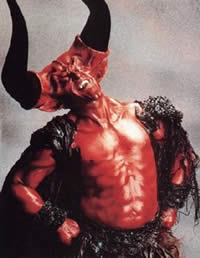 Unspeakable Horror blog ponders the Devil's abdomen and the allure of Satanic queerness...
Unspeakable Horror blog ponders the Devil's abdomen and the allure of Satanic queerness...
As a closeted gay kid, raised with a mega-dose of all-American homophobia, the "allure of evil" in horror films reflected the fear of gay desire and the fear of being identified with the queer "other" in society. As the son of a preacher, no one was more "other" than Satan, and it's no coincidence that I went through a strange and horrible little phase in Junior High, during which I was preoccupied with the fear of being possessed by the devil. For me, Satan was always highly charged with forbidden sexual desire.
In the seventh grade, Ridley Scott's Legend hit the theaters, and I remember picking up the record album soundtrack, despite the highly erotic image of Tim Curry as the devil on the cover of the album, which really disturbed and fascinated me. With a finely sculpted, shiny red chest and highly phallic set of massive horns, Tim Curry's devil character exudes sex. I had a very similar response of fascinated repulsion when I saw Tim Curry in The Rocky Horror Picture Show for the first time at the midnight movies.
Around the same time that I purchased the Legend soundtrack, I had a nightmare about the devil, during which I was walking to school, and the devil tried to abduct me from the sidewalk--actually, all he did was ask me if I wanted a ride, but he was shirtless with shiny purple lipstick. The sexual intention of the offer was clear to my adolescent brain. He wasn't red this time, and he didn't have horns, but I knew it was Satan.
A couple years later, Lost Boys was released. Like Tim Curry, Kiefer Sutherland as the lead vampire represented the ultimate in queer sex appeal: he lives a forbidden lifestyle, retreating to the shadows and creating his own family composed entirely of boys with really cool fashion sense--and the blood drinking--clearly a Freudian metaphor if there ever was one. Just like I was afraid the devil would take over my body and "recruit" me to his team, I was terrified (and fascinated) by the allure of the vampire boys. I even had a vampire nightmare that I had been bitten and was turning into a vampire beyond my control.
Being possessed by the devil or turning into a vampire both represented my fear of losing my preacher-kid facade and becoming gay. Of course it was inevitable. For me, the sexual allure of these evil, monstrous characters was clearly connected to my own internalized homophobia and awakening to forbidden sexual desire.
As a concluding note, I went to see Hellboy II yesterday, and I couldn't help but ogle Ron Perlman's sculpted red chest and abs. Hellboy is hot. I guess I still have a thing for devils.
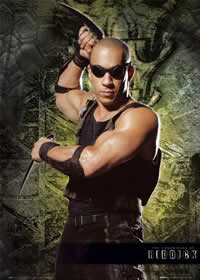 John Kenneth Muir's Reflections on Film and TV blog looks at Riddick’s redemption...
John Kenneth Muir's Reflections on Film and TV blog looks at Riddick’s redemption...
Why are modern audiences, and more specifically, genre aficionados, fascinated with Evil? There are likely as many reasons for this ongoing viewer attraction with “The Dark Side” as there are prominent examples of Alluring Evil populating our movie and TV screens.
Gazing at popular genre films and television, we might pinpoint one answer to this dilemma, or at least one clue. Perhaps the allure of evil resides entirely in the possibility of redemption.
After all, redemption is a ubiquitous notion. From Darth Vader in Star Wars (1977) to TV vampire icons like Barnabas Collins, Angel and Nick Knight, attentive viewers have watched with obsessed fascination as Evil with a capital “E” has been transformed into Good, usually by the pure of heart. Whether it is the love of a son that transforms Evil (as in Vader’s case), the love of a Chosen One (in Angel’s situation), or even a serial killer’s love of justice (suggested in Showtime’s Dexter), the tale of redemption (and sometimes simply the quest for redemption) is one that doesn’t appear to grow tiresome. On the contrary, this is a genre convention we enjoy seeing repeated.
The Cenobite leader Pinhead, for example, faced with a “greater” evil in the person of Dr. Channard, intervenes to help final girl Kristy, and sees his humanity restored (albeit very briefly…) in Hellbound: Hellraiser 2 (1988). Mafioso Michael Corleone searches desperately for a way out of his life of crime, attempting to become legitimate in the eyes of Big Business and Big Religion (the Vatican), but fails…rather epically, in Godfather Part III (1990). Soldier villain May Day (Grace Jones) renounces evil and sacrifices her life to save others in A View to a Kill (1985) and on and on the list goes.
Sometimes it actually seems that the more reprehensible a character, the more viewers enjoy experiencing the often arduous process of redemption. Case in point: Richard P. Riddick (Vin Diesel), the muscle-bound, gravel-voiced anti-hero of David Twohy’s futuristic film noir, Pitch Black (2000). This man’s heart is black as night. His eyes are literally steely. His psyche consists as much of animal instinct as evolved thought (the reason, perhaps, he remains restive and calculating even in cryo-sleep). He has all but conquered physical pain, in one instance dislocating both his shoulders to escape imprisonment. Like many representatives of evil in the media, Riddick seems simultaneously sub-human and super-human.
This gripping futuristic film depicts Riddick amongst the survivors of a harrowing spaceship crash as they reckon not only with an inhospitable desert planet far from the commercial space lanes, but also with the environment’s indigenous population: carnivorous, flying dragons that hunt by night (by the millions…) and are very, very hungry.
When a long-lasting eclipse grants these flying demons dominion, the human survivors reluctantly turn to the outcast of their bunch to see them through the crisis. That man – that brute -- is Riddick. He is well-acquainted with the dark, you see, and the only man with the vision to face it and fight it.
Yet by any conventional human definition, Riddick is “Evil.” He is a committed lawbreaker (an escaped convict and murderer of a space pilot, by his own admission). His very presence provokes fear in others. Why? Well he’s a bad-ass who might just “skull fuck you in your sleep.”
But there’s more.
Riddick also fulfills other crucial components of the descriptor “Evil.” For instance, he is willfully profane. He angrily rails against faith and informs an Imam “I absolutely believe in God. And I hate the fucker.”
Riddick, sharing a character trait with Old Scratch himself, is also a consummate seducer. Near the film’s climax, when he has reached an escape skiff, Riddick attempts to convince the young captain, Fry (Radha Mitchell) to abandon the other stranded survivors. He compliments her strong survival instinct, noting that he appreciates that quality “in a woman.” Then he plays to her weakness. “No one is going to blame you. Save yourself.” He says soothingly, almost mockingly. Along with Fry, we in the audience weigh Riddick’s words. There’s a ruthless logic to his suggestion. A basis for reasonable agreement.
Survival of the fittest and all…
But something inside -- whether conscience, remorse, decency, or perhaps all of the above--won’t allow Fry to abandon the others; to join Riddick in his sociopathic ways. So instead, Fry decides to change him. And that’s where the journey to redemption begins in earnest.
Ultimately, Riddick can be embraced by us decent folk because in him is that all-important seed, that opportunity, for change. This evil character unexpectedly and rather tragically rejoins the human race during Pitch Black’s finale when Fry risks (and loses…) her life to save him from the monsters. That heroic, unselfish act changes Riddick in ways he can’t even begin to understand. Insert Christ metaphor of your choice here…
“Not for me!” Riddick shouts angrily, flabbergasted and angry that Fry has--in essence--re-activated his conscience. He doesn’t want the redemption, but it finds him nonetheless. He feels unworthy of it; he doesn’t want it.
After his escape from the planet, a chastened Riddick finally tells another survivor (a child named Jack) that “Riddick died somewhere on the planet,” an indicator that his heart has indeed been changed; that he has undergone a transformation analogous to one suggested by writer Tennessee Williams. That “Hell is yourself” and “the only redemption” occurs when a “person puts himself aside to feel deeply for another person.” That’s what Fry did for Riddick; that’s what Riddick subsequently does for the remaining survivors of the crash.
Finally, I should make note that Pitch Black’s tag line states “Fight Evil with Evil.” Not "Beat Evil with Evil."
Because, in the final analysis, it is not Evil that ultimately wins in Twohy’s film; but rather nobility and heroism (Fry’s). Consequently, Riddick’s journey from sociopath and scoundrel to redeemed human being is one that viewers can wholeheartedly approve of. We can all countenance Evil if it pays the price for sinning; if it spies an ugly reflection in the mirror and joins the rest of us in recoiling at the sight. Riddick has finally turned those shining eyes on himself, and emerged, at long last, from the dark.
At least until the sequel.
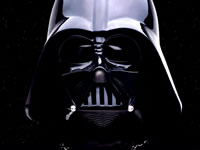 Groovy Age of Horror blog doesn't find most evil all that alluring...
Groovy Age of Horror blog doesn't find most evil all that alluring...
Not all evil is equally alluring. The pimply, sniveling, backstabbing weasel; the fat, sweaty, sadistic thug; the banal bureaucrat who "just follows orders"; the pitiful loser who "goes postal"; the petty crook, tiresomely destined to incarceration--these aren't exactly the stuff of fantasies.
When evil is alluring, it is the stuff of fantasies, mainly about dominance (Darth Vader, Doctor Doom), submission (Nazisploitation--where evil is often alluring from the victim's point of view), rebellion (Bonnie and Clyde, Milton's Satan), and/or the wages of sin (enjoying extravagance and indulgence that heroes are often expected to deny themselves). Villains who lend themselves well to such fantasies tend to be free of certain kinds of flaws: they're not ugly, pathetic, weak, cowardly, incompetent, inconsequential, ignoble, stupid, lacking in personality, etc. On the contrary, they're glamorized with any number of highly desirable strengths, qualities, or virtues. Even those who aren't physically attractive in any conventional sense tend to be endowed with an otherwise fascinating presence or appearance.
In the case of femmes fatales and "bad boys," an explicitly sexual allure is actually a defining aspect of their evil. This derives mainly from the traditional equation of sexuality and sin. Also, who hasn't, at one time or another, been seduced into something sorely (but not entirely) regrettable?
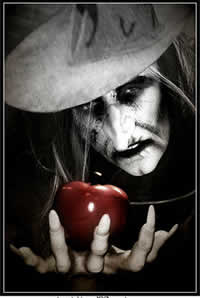
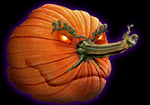


Thanks for passing this along, John. I appreciate the comments, but would respectfully have some level of disagreement. On the one hand, concepts of good and evil are informed by culture, yet to distill them to nothing more than cultural constructs with no transcendent reference or ground is to assume a particular metaethical perspective, and one that is reductionistic. Second, anger and fear are indeed part of the horror experience, and experiences in common between humanity and the rest of the animal kingdom. However, humans, due to their self-awareness and knowledge of mortality, also react with a sense of terror to various stimuli, including horror imagery. The author of this post has touched on some important issues, but in my view, has reduced a complex and multi-layered set of issues so as to become simplistic.
Posted by: TheoFantastique | July 31, 2008 at 11:50 AM
I'd look to something a bit more fundamental than Good and Evil, which are, after all, cultural constructs. I think the axis that defines horror -- and our relationship to monsters and villians -- is Anger and Fear.
Anger and Fear are primary emotions (the other two being Joy and Sadness), and the physiological and biochemical markers that indicate Anger and Fear are present in all mammals. I don't think a dog or an aardvark knows what Good and Evil are, but they know Anger and Fear.
The monster appeals because the monster is a vehicle through which we can express our Anger, which we, as social animals with a culture, cannot otherwise give free rein.
For me, the really interesting thing about Horror, and the place where horror "works" for me, is what I call "the flip." The flip occurs when our identification with the monster's anger becomes overwhelmed by our fear for the protagonist.
In a simple morality play like a slasher film, this is explicit -- POV shots identify us unambiguously with the monster, and we feel some justification in enjoying the violent demise of the morally flawed (or simply annoying) characters, until Final Boy is killed, and -- flip! -- fear takes over, and our sympathies lie with Final Girl, the embodiment of Fear. Moral and social order is restored, and a bunch of stoned teenagers leave the theater ready to become productive members of society.
But the flip between anger and fear can be much more subtle and less socially comfortable. Take a classic like James Whale's Frankenstein. There's a movie that flips back and forth between embracing Anger and Fear constantly, and the objects of Anger and Fear constantly shift. When Dwight Frye torments the Creature, we identify with the Creature's anger, but when the Creature tosses the little girl in the lake, we flip perspective to the grieving woodsman and the frightened villagers. Then the villagers let their fear overwhelm them and become an angry mob -- flip. It's an incredible balancing act.
A film like Frankenstein offers no simple moral fable, but it offers (to me, at least) and chance to get through another fucking day.
Or maybe this is all BS, and I'm just really, ... *really* ... **angry.**
Posted by: HP | July 31, 2008 at 10:19 AM